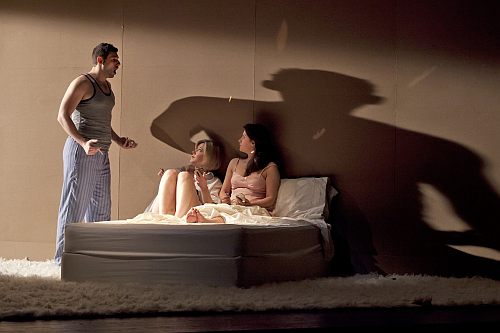 United States Mozart, Il sogno di Scipione: Gotham Chamber Orchestra and Chorus, Neal Goren (conductor), Gerald W. Lynch Theater at John Jay College, New York, 11.4.2012 (SSM)
United States Mozart, Il sogno di Scipione: Gotham Chamber Orchestra and Chorus, Neal Goren (conductor), Gerald W. Lynch Theater at John Jay College, New York, 11.4.2012 (SSM)
Production:
Director: Christopher Alden
Set Design: Andrew Cavanaugh Holland
Costume Design: Fabio Toblini
Lighting Design: Allen Hahn
Cast:
Scipione: Michele Angelini
Constanza: Marie-Ève Munger
Fortuna: Susannah Biller
Publio: Arthur Espiritu
Emilio: Chad A. Johnson
Licenza: Rachel Willis Sørensen
Nurse: Maeve Höglund

This free-spirited and imaginative production of Mozart’s early opera Il sogno di Scipione succeeds in a way that other anachronistic stagings of opera do not. The conceit of a dream (sogno) provides the license for the director to create a staging that goes beyond the restraints of reality. Since the opera was never performed in its entirety in Mozart’s lifetime (and not revived until 1979), there really is no precedent as to how it would have been or should be staged. The one performance on DVD, recorded at the 2006 Salzburg Festival, conceptually mirrors the Gotham’s interpretation.
It is hard to believe that this opera was written by a boy of sixteen, and even harder to believe that it is Mozart’s seventh opera. The libretto tells of a dream had by the
young Scipione, the future defeater of Hannibal. Waking up in a bedroom, Scipione finds himself if not in a ménage à trois, definitely à trois. Michele Angelini as Scipione is asked to choose between two women, personifications of Fortune (Susannah Biller as Fortuna) and Constancy (Marie-Ève Munger as Constanza). Tempted by Fortuna, who dresses and undresses and appears in various states of dishabille, Scipione resists her wiles and chooses, as Mozart himself did, Constanza.
Il sogno di Scipione suffers from a plot based on a simple kind of personification that was typical of operas, oratorios and masques written at the turn of the 18th century. Handel’s Il Trionfo del tempo e del Disinganno with characters named “Beauty,” Time” and Pleasure,” and his more famous L’allegro, Il Penseroso ed Moderato, are examples of libretti based on personifications. The music has an older generation feel to it with its da capo arias, more Baroque than galant. Much of the singing consists of highly embellished arias typical of Handel, Hasse and A. Scarlatti.
This is early Mozart, but it is not easy Mozart. The cadenza-like melismas at the completion of the arias were sometimes hard work for the young singers. But whatever was lacking in reaching the high C’s was made up for in enthusiasm and spirit. The strongest vocal performance came from Arthur Espiritu’s Publio who sang majestically while hopping around on one leg. The non-sequitur ending with its appeal to patrons by the soprano Rachel Willis Sørenson was expertly sung, but her attempts to be flirty were not greatly convincing.
Goren led the orchestra in a bright and brisk rendition of the overture and settled in to a comfortably paced regimen that was well-balanced and supportive of the singers. This was an adventuresome and imaginative introduction to the young Mozart’s accomplishments.
Stan Metzger